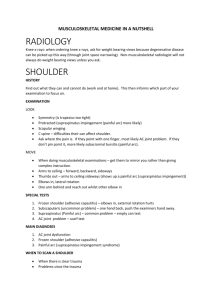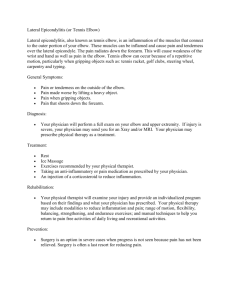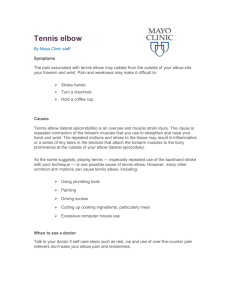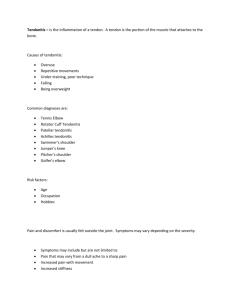5-13-98 to 6-8-98
advertisement
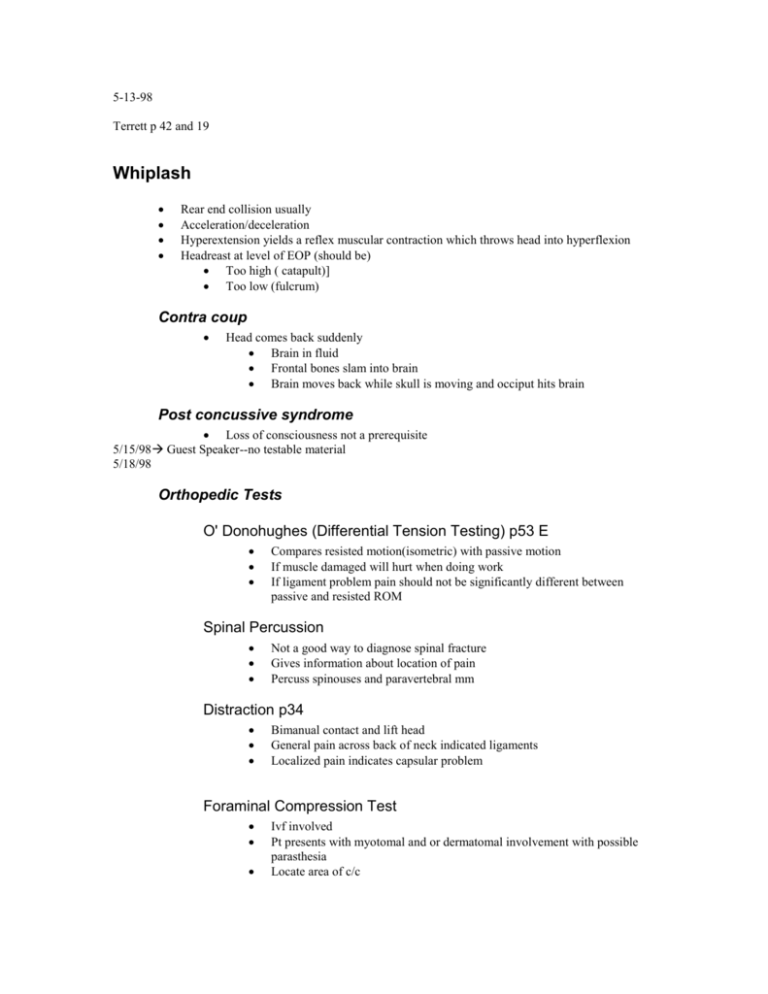
5-13-98 Terrett p 42 and 19 Whiplash Rear end collision usually Acceleration/deceleration Hyperextension yields a reflex muscular contraction which throws head into hyperflexion Headreast at level of EOP (should be) Too high ( catapult)] Too low (fulcrum) Contra coup Head comes back suddenly Brain in fluid Frontal bones slam into brain Brain moves back while skull is moving and occiput hits brain Post concussive syndrome Loss of consciousness not a prerequisite 5/15/98 Guest Speaker--no testable material 5/18/98 Orthopedic Tests O' Donohughes (Differential Tension Testing) p53 E Compares resisted motion(isometric) with passive motion If muscle damaged will hurt when doing work If ligament problem pain should not be significantly different between passive and resisted ROM Spinal Percussion Not a good way to diagnose spinal fracture Gives information about location of pain Percuss spinouses and paravertebral mm Distraction p34 Bimanual contact and lift head General pain across back of neck indicated ligaments Localized pain indicates capsular problem Foraminal Compression Test Ivf involved Pt presents with myotomal and or dermatomal involvement with possible parasthesia Locate area of c/c With head in neutral position, press down on top of head and look for increase in radicular pn Then laterally bend pt and compress Then laterally bend and rotate and then compress If problem in compression, distraction provides relief 5/20/98 Muscle Strain Grading 1. 2. 3. Mild May be only microscopic damage or can be macroscopic but damage is small May heal completely Moderate Capillary damage Longer to heal More scar tissue (stiffer ) decr ROM severe (rupture: tearing of at least part of the tendon) surgical repair often necessary Sprains (Ligaments) 1. 2. 3. mild moderate severe (separation/rupture or avulsion fracture) see rubor, calor, dolar, tumor in sprain damage to proprioceptors (can lose functional aspects of ligaments) usually take longer to heal than muscle more movement allowed which can lead to secondary injury, but less pain poor vascular supply 5/22/98 Post Concussive Syndrome symptoms light headedness vertigo/dizziness headache neck pain photophobia (aversion to light) phonophobia (aversion to loud sounds) tinnitus impaired memory easily distracted impaired comprehension forgetfulness insomnia fatigues easily outbursts of anger mood swings depression loss of sexual drive intolerance to alcohol hard to document that the symptoms are from the accident PET scan of brain (be sure insurance will pay) Proprioceptive Neuromuscular Facilitation (Voss) Stroke rehab Thyroid Damage Symptoms take a while to develop Fatigue Decr labido Weight gain Forgetfulness Often attributed to malingering 5/27/98 Video on whiplash Thoracic Outlet Syndrome Scalenius Anticus Syndrome Compression of the neurovascular bundle as it exits between anterior and middle scalenes Usually secondary to cervical injury Hypertonic scalenes Post stenotic dilitation of the subclavian artery May hear bruit Neurologic and vascular symptoms Main test: Adson's Cervical Rib Syndrome May be bone or cartilage Forms a ridge that takes up space in scalene triangle Costoclavicular syndrome Carrying backpack, suitcase, etc. Shoulder injuries Clavicular and 1st rib fixations Eden's test Hyperabduction Syndrome Abduction of the arm increases Hypertonicity of the pec minor Rib fixation Shoulder injuries Can compress axial artery and brachial plexus People who work overhead a lot can develop this Aka Pec Minor coracoid syndrome or P. minor compression syndrome 5/29/98 TMJ Hinge jt with anterior translation When opening jaw, rotation 1st then anterior translation Often injured in whiplash Review anatomy When palpation check for differences in timing and degree of opening Check whether teeth fit together well 6/1/98 Shoulder Apley's Scratch Test Have pt reach above their shoulder with one hand and touch shoulder blade and other hand under shoulder and try to approximate the hands Look for lack of pain ??? Look for assymmetry If you see a problem it is probably rotator cuff mm Same as deep knee bend (lower ext) Dawbarn's P104 Subacromial bursa involved Bring arm into extension and palpate the bursa Pt presents with history of shoulder pain Abduction of the arm relieves the pain Ludington's Test sp??? Pts hands behind head Palpate biceps mm for symmetry If long head of biceps tendon ruptures, initially looks bigger then atrophies Codman's Sign Passive abduction of pt shoulder Dr drops arm and pt tries to stop Dr feels for contraction of the delts Pain with rupture of the supraspinatus or joint capsule Modified codman's: abduction against resistance Impingement Sign Supraspinatus tendinitis Supraspinatus or biceps tendon Palpate at site of supraspinatus insertion Tendonitis Can get calcium deposits Body stablilizing area Bursitis Usually secondary to something else (tendonitis) With acute tendonitis and bursitis, area get real red Shoulder Dislocation Usually anterior and inferior Calloway's Test Measure from axilla to acromion process The larger side is the dislocated side due to neck of humerus dropping down Dugas Test ??? Hard to Read page 44 of Linda's Notes With affected side, have pt grab other shoulder then push elbow into chest Pt will deck you if shoulder dislocated Mazion Shoulder Maneuver Same as Dugas but try to raise elbow up If dislocated pain in front of acromion Apprehension Test Abduct shoulder to 90 deg. And flex elbow Look for apprehension on pt face 6/3/98 Adhesive Capsulitis Frozen shoulder - aka Usually secondary to tendonitis or bursitis Pt uses less which allows for adhesions to form Codman's Pendular Exercises 6/5/98 Use pendular motion and go into painful ROM and to often each day Rotator Cuff Tears Luddington's Check for symmetry of the biceps (rupture of tendons) Rheumatoid Arthritis Inflammatory condition Hot swollen painful red joints Synovial hypertrophy Pannus formation Erosion of menisci Instability Later on get complete loss of joint function due to ankylosis Stages 1. acute 2. proliferation of pannus 3. fibrotic ankylosis 4. bony ankylosis 2-3 X more common in females *** symmetrical in presentation **** check for stability especially in C1/C2 area if too much space between ant. Arch of the atlas and dens can get cord compression autoimmune in nature ulnar deviation of fingers carpal bones become hard to identify flexion deformity of thumb (boutonniere) swan neck deformity of fingers rheumatoid nodules appear in connective tissue near jt. Baker's cysts: synovial outcroppings popliteal region Supraspinatus Press Test 130 Abduct shoulder to 90 degrees and resist abduction Abbot-Saunders Abduct and extern rotate Bring arm down Listen for click or pop of bicipital tendon Instability of transverse humeral ligament Elbow Valgus: lateral deviation Vlagus stress test : tests medial collateral ligament distal body part to the joint is in the more lateral position Varus Distal part to the joint is in the more medial position Varus Stress Test is aducting the distal part and testing lateral collateral Tinel sign of elbow Huge % of false positives Tests ulnar and radial nerves Lateral side of olecranon radial n Medial side ulnar n Tendonitis of the Elbow Common Extensor Tendotinits Tennis Elbow Lateral epiconylitis Pain more commonly in forearm just distal to elbow Flexor Tendinitis Golfer's elbow Medial epicondylitis Ligamentous Instability Test 154 Elbow slightly flexed to 20 deg Hand in supination Stabilize arm Abduct forearm to test medial collateral (valgus) Adduct forearm to test lateral collateral (varus) If grade III sprain expect hypermobility Elbow Flex Test 148 Maintain forced flexion for > 5 min Cozen's Test *** standard elbow test ***** Flex elbow Pronate forearm Wrist extended Pt resists wrist flexion from Dr. Mill's *****standard elbow test ****** Elbow in flexion .flex wrist, then fingers bring elbow into extension and pronation with wrist and fingers still flexed Cabil Test ?????? check spelling have pt squeeze sphyg bulb place band around extensors and do again should be stronger with band if tennis elbow Golfer's Elbow Test elbow flexed, supinated forearm and extended wrist pt. Tries to flex
